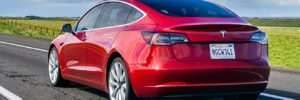
Tesla’s plan for a network of self-driving taxis (then called The Tesla Network) was first mentioned in July 2016, as part of the company’s Master Plan, Part Deux:
When true self-driving is approved by regulators, it will mean that you will be able to summon your Tesla from pretty much anywhere. Once it picks you up, you will be able to sleep, read or do anything else en route to your destination…You will also be able to add your car to the Tesla shared fleet just by tapping a button on the Tesla phone app and have it generate income for you while you’re at work or on vacation.
Since then, we’ve heard little about the concept—not because Elon Musk and company forgot about it, but rather because two things need to happen before it can become a reality. First, Tesla vehicles need to be upgraded to enable full Level 5 autonomy. Second, an alphabet soup of regulatory agencies need to give their approval.
At Tesla’s Autonomy Day event last year, Musk announced that Tesla planned to launch a self-driving network of one million vehicles by the end of 2020 (the term “Tesla Network” seems to have been dropped in favor of “Robotaxis”).
Now the Iron Man has confirmed that this year’s launch is still on, pending regulatory approval.
“Functionality still looking good for this year. Regulatory approval is the big unknown,” tweeted Musk.
Musk also confirmed that Model 3’s mysterious internal camera is, just as many have suspected, intended to keep an eye on riders when the car is in use as a Robotaxi.
Shortly after Model 3 deliveries began, astute owners noticed that the new EV had a couple of interesting features that Models S and X lack—and it just happens that those features would be mighty handy for a self-driving taxi. One of these is the ability to control most vehicle functions remotely, which would allow riders to unlock the car without the owner being present, and would allow owners to lock storage areas such as the glovebox and/or frunk, making them inaccessible to riders.
However, the really intriguing feature, included on all Model 3s but so far unused, is an internal camera that allows the passenger cabin to be viewed remotely. This would overcome the number-one objection to allowing your car to be used as a Robotaxi: riders are assumed to be prone to throwing up.
In response to a Twitter user, who speculated that the camera “is most likely for Robotaxis, if they vandalize your car, it’s on camera,” Elon simply tweeted: “Correct.”
Of course, the camera, which seems to offer a wide-angle view of the entire passenger cabin, has several possible applications: it could serve as a part of Sentry Mode in case the vehicle is broken into, or it could be used to help the car recognize the occupants and adjust preferences accordingly. Parents, jealous spouses and evil dictators will also doubtless find uses for such a surveillance device.
Can Elon and his mad scientists really bring such a momentous project to fruition by the end of this year? He did give himself some wiggle room by saying that the timeline depends on “regulatory approval.” It seems likely that certain cities and/or states will be quicker to grant their blessing than others. However, if and when Tesla brings even a limited network of Robotaxis into service, it will begin a radical restructuring of the world’s transportation system—and eventually, many other aspects of society. Watch out!
Source: Electrek (cabin camera), Electrek (Robotaxi plan)
source https://chargedevs.com/newswire/elon-musk-says-a-network-of-a-million-self-driving-tesla-taxis-is-still-on-schedule-to-launch-this-year/
No comments:
Post a Comment